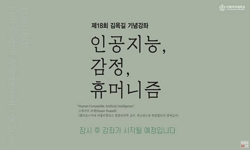In the field of cognitive science one of the most research topics is the notion of AI and the ‘self’. This paper intends of examining this topic by comparing the tradition of cognitive science with that of Buddhism, namely in relation to the conce...
http://chineseinput.net/에서 pinyin(병음)방식으로 중국어를 변환할 수 있습니다.
변환된 중국어를 복사하여 사용하시면 됩니다.
- 中文 을 입력하시려면 zhongwen을 입력하시고 space를누르시면됩니다.
- 北京 을 입력하시려면 beijing을 입력하시고 space를 누르시면 됩니다.

인공지능의 자아 정체성 문제를 통해 본 인지과학과 불교의 ‘자아 없음’ 입장 비교 = A Comparison and Examination of Cognitive Science and the Buddhist concept of ‘No-Self’ in Relation to the Problem of AI Self-Identity
한글로보기https://www.riss.kr/link?id=A109165869
-
저자
이충현 (동국대학교 동서사상연구소)
- 발행기관
- 학술지명
- 권호사항
-
발행연도
2024
-
작성언어
Korean
-
주제어
Artificial Intelligence ; Buddhism ; Cognitive Science ; Self-identity ; Defilement ; 인공지능 ; 인지과학 ; 불교 ; 자아정체성 ; 번뇌 ; 무아
-
등재정보
KCI등재후보
-
자료형태
학술저널
-
수록면
183-211(29쪽)
- DOI식별코드
- 제공처
-
0
상세조회 -
0
다운로드
부가정보
다국어 초록 (Multilingual Abstract)
In the field of cognitive science one of the most research topics is the notion of AI and the ‘self’. This paper intends of examining this topic by comparing the tradition of cognitive science with that of Buddhism, namely in relation to the concept of the ‘no self’. Significantly both traditions share the view that the substantial self is illusory. That is to say, that within these discourses ones perception of the self is an illusion. However, this illusion of the self is inevitable and essential as it allows the subject to operate within reality, for self- identification with its ‘I’. This aspect of the self that the subject regards as I is ‘self-indentity’. It is not not static but is constantly in a state of flux because it is continuedly being amended based upon the subject’s experiences. Although this largely true of both the cognitive science and Buddhism, they deviate substantially on the formation of self-identity. Unlike cognitive science’s perspectives, that of Buddhism is based upon the idea that defilements(kleśas) exert a profound influence on how the ‘I’ comes into being. According to Buddhism, defilements are negative-operative forces that are not fully integrated into the consciousness. The self-indentity of AI will differ greatly from that of human consciousness because it lacks these negative-operative forces. Therefore, there will be disparity in the scope and value when examining and comparing self-identity between the two domains.
동일학술지(권/호) 다른 논문
-
코로나19 팬데믹 이후 공공 전시이벤트에서 나타난 포스트휴먼과 이주·탈식민의 미술적 양상들
- 대구가톨릭대학교 인문과학연구소
- 김동일
- 2024
- KCI등재후보
-
<오토마타>에 나타난 기계의 자의식과 포스트휴먼의 도래
- 대구가톨릭대학교 인문과학연구소
- 조민현
- 2024
- KCI등재후보
-
기술적 기후 재앙과 더스트 생태학자의 환영 - 김초엽의 『지구 끝의 온실』을 중심으로
- 대구가톨릭대학교 인문과학연구소
- 오윤호
- 2024
- KCI등재후보
-
나희덕의 시와 시론에 나타난 포스트휴먼 시대 공생의 상상과 윤리 - 2010년대 이후 작품을 중심으로 -
- 대구가톨릭대학교 인문과학연구소
- 황선희
- 2024
- KCI등재후보
분석정보
연관 공개강의(KOCW)
-

[제18회 김옥길기념강좌] 인공지능, 감정, 휴머니즘(Human-Compatible Artificial Intelligence’)’
이화여자대학교 스튜어드 러셀 -

누구나 할 수 있는 데이터 분석과 인공지능[Data Analysis and Artificial Intelligence for Everyone]
K-MOOC 인하공업전문대학 이세훈 -

누구나 할 수 있는 데이터 분석과 인공지능[Data Analysis and Artificial Intelligence for Everyone]
K-MOOC 인하공업전문대학 이세훈 -

인공지능
충북대학교 이건명 -

인공지능
연세대학교 윤한얼




 KCI
KCI KISS
KISS

